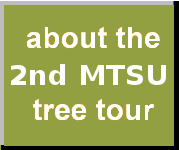
|

|

|

|
An individual instance of Quercus alba (white oak)
Permanent unique identifier for this particular organism:
http://bioimages.vanderbilt.edu/mtsu/22
Notes:
Description
Quecus alba L., white oak, grows from Maine to Minnesota southward to Florida and Texas. It is a large, stately tree that grows up to over 100 feet tall, and 38 to 50 inches in diameter, with a round to wide spreading irregular crown. White oak bark is whitish or light gray, varying from scaly to irregularly platy or ridged and furrowed. Leaves are simple and alternately arranged on the stems; they are 5-6 inches long and have a rounded tip and wedge-shaped base, with evenly notched edges; leaves are bright green above and whitish underneath. Male flowers are green and 2-4 inches long, while female flowers are reddish and they appear as single spikes with the leaves. White oak acorns are oval; about a quarter of the acorn body is covered with a cap which drops off at maturity.
Uses
Wildlife: Acorns are eaten by squirrels, blue jays, crows, red-headed woodpeckers, deer, turkey, quail, mice, chipmunks, ducks and raccoons.
Timber: White oak's wood is strong and durable for staves for barrels, lumber, flooring, and interior woodwork.
Recreation and Beautification: White oak is an excellent ornamental tree because of its broad round crown, dense foliage, and purplish-red to violet-purple fall color.
Adaptation and Distribution
Although found on many soil types, white oak does best on coarse, deep, moist, well-drained, with medium fertility, and slightly acid soils. It is well adapted to heavy soils and north and east-facing slopes. Natural stands are often found in areas with loam and clay soil.
Establishment
Fall seeding is preferable to spring seeding. White oak acorns have no dormancy and germinate immediately following seeding. Existing trees are very sensitive to disturbances in their root zones caused by grading, soil compaction, or changes in drainage patterns; if severe, these disturbances can lead to mortality.
References
USDA NRCS (2002). White oak plant fact sheet. Retrieved from http://plants.usda.gov/java/factSheet

|

|
|
Load database and switch to thumbnail view
Use this stable URL to link to this page:
http://bioimages.vanderbilt.edu/mtsu/22.htm
This particular organism is believed to have managed means of establishment.
This organismal entity has the scope: multicellular organism.
Identifications:
Quercus alba
L.
sec. Tennessee Flora 2014
common name: white oak
family: Fagaceae
Identified 2016-03-13 by Patrick Phoebus
Location:
Old Main Circle, Peck Hall, Rutherford County, Tennessee, US
Click on these geocoordinates to load a map showing the location: 35.8487°, -86.3687°
Coordinate uncertainty about: 10 m.
Altitude: 190 m.
Location calculated as average of its images' coordinates.
Occurrences were recorded for this particular organism on the following dates:
2016-03-13
2016-04-27
The following images document this particular organism.
Click on a thumbnail to view the image and its metadata. Load database and enable navigation by taxon and organism.
| Image | View |
|
|
whole tree (or vine) - general |

|
whole tree (or vine) - winter |
|
|
whole tree (or vine) - winter |
|
|
bark - unspecified |
|
|
leaf - showing orientation on twig |